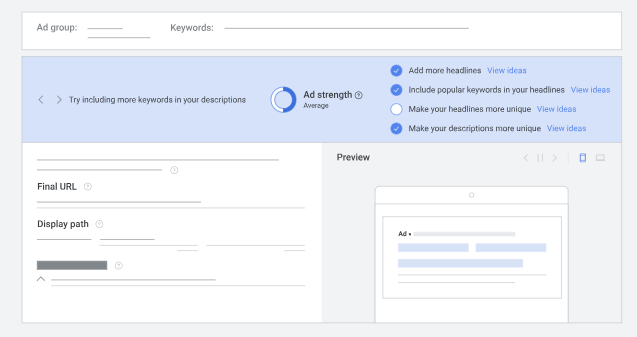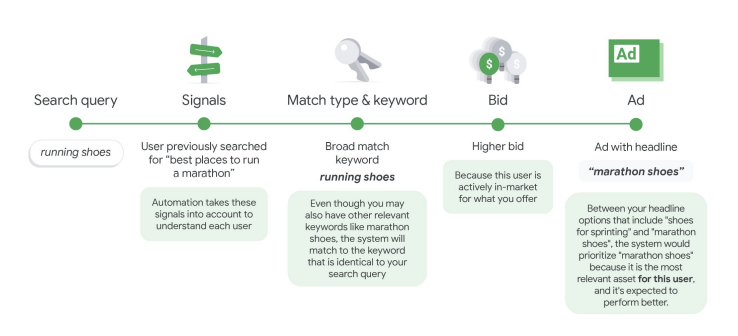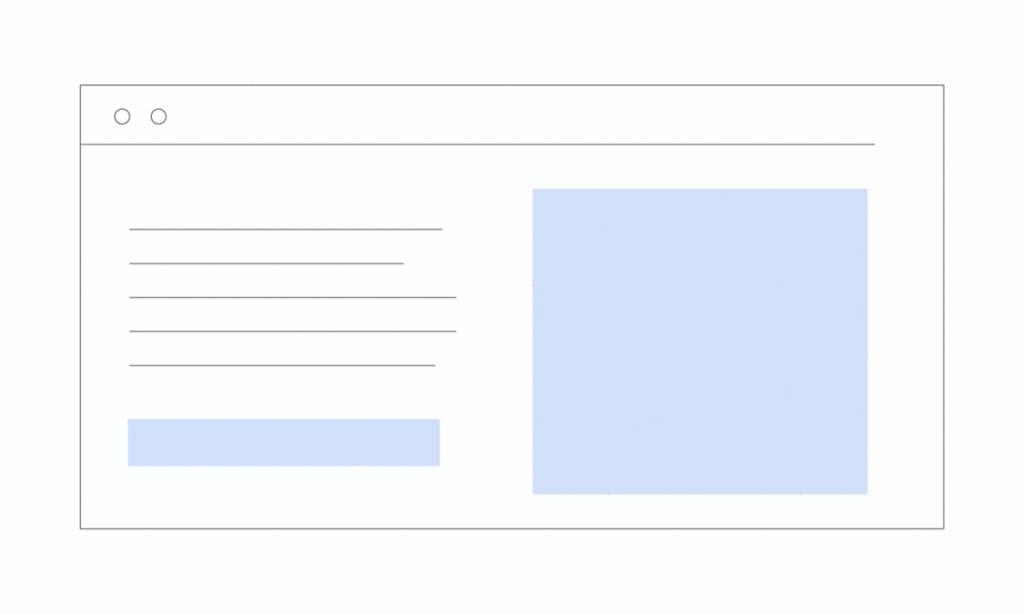When it comes to eCommerce Google Ad relevancy, you can’t beat Google responsive search ads.
Since Google phased out the expanded text ad, Google responsive search ads, or RSAs, have become a staple in today’s eCommerce digital advertising landscape.
By combining the power of Search with advanced machine learning AI, advertisers can automatically test different combinations of headlines and descriptions. This ultimately ensures the right searcher sees the right combination at the right time to elicit a click.
But to harness their power, you need to ensure that you have not only understood how they work and set them up like a pro but followed the right expert best practices.
This is where we come in.
In this post, we take you through everything you need to know about responsive ads and how you can better set yourself up for improved conversions for less spend. In other words, excellent ROAS.
Here is a complete breakdown of what we will cover.
Guide to High-Performing Google Responsive Search Ads
- What Are Responsive Search Ads?
- Benefits of Using RSAs
- How Do Google Responsive Search Ads Work?
- Responsive Ads vs. Dynamic Search Ads
- Responsive Search Ads vs. Google Responsive Display Ads
- How to Set Up Google Response Ads Like a Pro?
- Responsive Search Ads Examples and RSA Case Studies
Let’s jump in.
1. What Are Responsive Search Ads?
Responsive search ads are automatic search ads (text ads) that dynamically change according to the search a potential customer is using. With RSAs, an eCommerce marketer initially enters multiple headlines and descriptions, and Google will then test the combination to learn the varieties that perform best for a specific search.
The bottom line is that Google designed RSAs to enable marketers and advertisers to find the best ad element combinations, on autopilot.
A Short Note about ETAs
As of June 2022, ETAs (expanded text ads) on Google Search were replaced by RSAs. The reason for this Google Ads change was to help simplify search ad creation for advertisers while driving better performance with the additional automation ad types such as RSAs offer.
As per Google, advertisers who switched from an expanded text ad to a responsive search ad saw an average of 20% more conversions — at a similar cost per conversion — when using the same assets as ad campaigns using broad match and Smart Bidding.
2. Benefits of Using RSAs
By adding responsive search ads to your digital marketing strategy, eCommerce marketers can experience five main benefits.
1. Improved Reach
Because responsive ads have multiple headlines and descriptions for Google to “choose” from, your automated search ads will compete in more auctions for more ad slots linked to more queries. This, in turn, ensures that your ads are shown to more potential customers and active product searchers.
2. Better Ad Performance
Unlike traditional text ads, responsive ads create a more personalized experience for Search.
And when you combine this relevancy with real-time optimization, your ad performance at the group and campaign levels is likely to improve.
This is because their real-time personalization is likely to result in more clicks. And the more clicks you get of highly targeted shoppers looking to buy exactly what you’re selling, the better your chances of conversions.
Bonus Content: eCommerce Keyword Research [Full Guide + Hacks]
3. Added Flexibility
RSAs offer a lot more flexibility than the more traditional extended text ads. There are two main areas of flexibility. One, these ads provide character flexibility and will match the widths of specific devices. Two, their ad copy combination automation means your messaging is not set in stone, with Google adjusting these to fit specific audiences.
4. Reduced PPC Management Admin
Unlike extended search and other ad campaign types, responsive ads require less PPC management. First, you reduce the time spent on ad creation by submitting headlines and descriptions upfront and in bulk. Next, because Google automates the testing process for you, you don’t have to manually tweak headers or descriptions until peak performance is reached.
5. Increased Conversions
Because RSAs are designed to always show the most relevant ad copy to a specific search, they have a chance of being exactly what a potential customer is looking to buy at that moment. Ultimately, when combined with all the other benefits mentioned, this is likely to result in higher conversion rates.
3. How Do Google Responsive Search Ads Work?
As we mentioned in the introduction of this post, RSAs take the multiple headlines and descriptions uploaded by an advertiser to provide a variety of combinations.
These combinations are then tested with Google’s machine learning algorithms to find the most effective match for each specific search query in real-time. Additionally, these ads are adapted to the device a potential customer is using, ensuring they fit the ad space perfectly.
Over time, Google’s algorithms learn which ads perform best, based on factors such as the search query, the device being used, the specific browsing behavior of each potential shopper, and other important signals.
Let’s take a closer look at the three essential elements that work together in order to make RSAs work.
Ad Components
Like legacy Google Search ads, three main components (or assets) make up RSAs: headlines, descriptions, and URLs. There are also two additional elements for responsive ads: the display path URL and Ad Strength Indicator. We will quickly describe each.
- Headlines. Google allows advertisers to submit up to 15 different headlines for each RSA, with up to 30 characters each. Google’s system will then test combinations to show multiple headlines (up to three) per responsive ad.
- Descriptions. Advertisers can submit up to four different responsive text ad descriptions, each with a maximum of 90 characters. These descriptions are mixed and matched based on ad performance, with Google displaying up to two descriptions at a time.
- Final URLs. These are the URLs of the landing or product pages you want a searcher to reach from your responsive ad. This clickable link should be highly relevant to your ad assets to ensure you create a seamless experience for the searcher.
- Display paths. Also known as the URL path, these are the URLs that a search will see, giving them a sense of where they will be landing when they click. An advertiser has the option (it’s not required) to add up to two URL path fields of up to 15 characters each.
- Ad Strength Indicator. This tool can be used in real-time to ensure the ad assets you’ve submitted for your responsive ad are relevant. It will also highlight quantity and ad content diversity, guiding you through suggested short headline and description improvements likely to boost ad performance.
[Source: Google]
Machine Learning
We know that machine learning is an integral part of eCommerce AI tools and optimization — especially when it comes to eCommerce ads like paid search marketing. In the case of responsive ads, Google’s algorithms use machine learning to test the various combinations, finding the most effective match for different search queries.
Bonus Content: AI for eCommerce: The Ultimate Guide
This AI-powered ad type is particularly effective when combined with Google’s responsive search ad types and broad match. The latter enables Google’s system the flexibility it needs to optimize the right ad asset or creative variant (in the case of a responsive display ad) for each query.
Below is a Google Search ad example showing how their responsive ad automation works using Smart Bidding and broad match keywords. Here you can see how Google’s machine learning AI incorporates multiple signals, ensuring that every person considers the ad most relevant to them.
[Source: Google]
Pro Tip: Get Additional Optimization AI for Your Google Campaigns for Free
If you want to incorporate the power of AI for all your digital marketing campaigns, then check out Traffic Booster. This unique AI-powered tool enables us to help you automate your Google, Facebook, and Instagram ads, ensuring you get the best out of digital marketing.
The result? Better ad performance for less spend! AKA, improved ROAS and more sales.
Adaptation and Optimization
Google’s responsive search ads machine doesn’t stop with creation. RSAs will continuously adjust to fit available ad space to ensure search ads look good in terms of header and description length on any device. It will also continually test ad copy combinations to always ensure that the best combination of headlines and descriptions is working together for optimum performance.
—
Still fuzzy on exactly how Google responsive search ads work? Here’s a video explaining exactly how.
4. Responsive Ads vs. Dynamic Search Ads
As we now know, to create RSAs, Google combines submitted headlines and descriptions to create search ad copy highly relevant to a searcher (and potential customer) at that moment.
Dynamic Search Ads also use headlines, descriptions, and machine learning. However, they differ in how the ad copy is generated.
With Dynamic Search Ads, Google will scan your store’s site to find the right product page for the searcher at that moment. They will also use site content to generate title ad copy for that ad.
[Source: Google]
Both types of ads have their benefits. However, generally speaking, dynamic ads are best for remarketing campaigns, while responsive search ads are great for brand awareness.
5. Responsive Search Ads vs. Google Responsive Display Ads
Like search ads, a responsive display ad allows an advertiser to upload various assets. Google AI will then generate ad combinations — for websites, apps, YouTube, and Gmail — in the form of image or video ads.
Recently replacing responsive ads as the default ad type for the Google Display Network, they can be used in standard Display campaigns, as well as Smart Display campaigns.
The main difference between responsive search ads and responsive display ads is the assets advertisers get to upload and where these ads are displayed.
In the case of responsive display ads, advertisers can also add images, product videos, and logos in addition to ad copy. These ads are displayed on Google’s Display Network.
6. How to Set Up Google Response Ads Like a Pro
RSAs are created in your Google Ads account as you would any other ad. First, you upload your final URL and display the path text. Next, you enter multiple headlines, followed by your descriptions. After which, you save your ad, and away you go.
Sounds simple, yes? Not so fast. There are a few things you should be doing within those steps to ensure you are set up for peak success. Let’s review these top RSA creation tips and must-knows.
- Keywords. Make sure you use your product keywords in your ad copy, but remember, these should flow organically and not look like keyword stuffing.
- Ad groups. You want to ensure you have at least one responsive search ad per ad group.
- Ad Strength. When uploading your ads, you want to ensure at least one response ad has at least “Good” or “Excellent” on the Ad Strength Indicator.
- Compatibility. It’s important to note that responsive ads can be shown in any order, so you want to make sure your headlines and descriptions make sense individually and in any combination.
- Maintenance. Yes, responsive ads use AI automation to boost ad performance, but that doesn’t mean you should just create and leave. You want to regularly review your performance and adjust your assets if needed.
- Optimization tools. Consider using our advanced PPC management tools to enjoy automation across all your ad campaigns — not just responsive ads — and free up even more time and budget while also improving ROAs. Find out more here.
- Legal and Compliance. Ensure that any assets you add comply with any industry legalities and are Google Ad compliant.
- Ad copy. If you have specific ad copy that needs to be shown in every responsive ad, no matter the combination, you will need to add the text in Headline position 1 or 2, or Description position 1. Additionally, don’t forget your CTAs (call to actions).
Bonus Content: 17+ Call-to-Action Examples: How to Create Converting eCommerce CTAs for All Marketing Channels
7. Responsive Search Ads Examples and RSA Case Studies
Tails.com Increase Traffic by 258%
According to a Google case study, the subscription pet food brand Tails.com were able to increase their traffic by as much as 258% by switching from broad match modifier keywords to broad match on generic campaigns. Additionally, their response ad campaigns resulted in a 182% increase in sign-ups.
Indie Vinyl Den Increased Sales by 132%
Merchant Indie Vinyl Den managed to increase their overall sales and generate 5X ROAS from all their Google Ad campaigns — including responsive ads, Dynamic Search Ads, and more, using Traffic Booster. Additionally, they saw a 132% increase in sales.
But Don’t Rely Too Heavily on Responsive Ads Without Considering the Bigger Picture
Now you have everything you need to get started with the Google responsive search ad format. There is no doubt that they can be effective.
However, they don’t perform well in a vacuum. You need to consider all your digital marketing channels and ensure they all work together to boost conversions.
Instead, all ad campaigns should be working together in Google and across all channels — like your eCommerce Facebook ads. And even better if you harness the power of AI for all your ads, not just Google responsive search and Display ads.
Want to know more? Reach out to us in the comments, or click the banner below.

Nicole is a content writer at StoreYa with over sixteen years experience and flair for storytelling. She runs on a healthy dose of caffeine and enthusiasm. When she's not researching the next content trend or creating informative small business content, she's an avid beachgoer, coffee shop junkie and hangs out on LinkedIn.
Recommended articles
 Facebook Ads for eCommerce: 16 Strategies, Examples & Tips
Facebook Ads for eCommerce: 16 Strategies, Examples & Tips
 How to Build a Winning eCommerce Ads Strategy
How to Build a Winning eCommerce Ads Strategy
 Google Ads for eCommerce: Everything You Need to Know
Google Ads for eCommerce: Everything You Need to Know
 10X Your Traffic with PPC Management Software
10X Your Traffic with PPC Management Software
Comments
Powered by Facebook Comments







